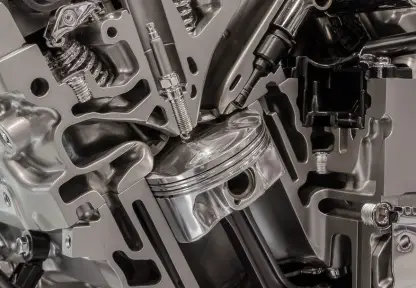
In the automotive industry, the development of gasoline direct injection (DI, GDI) engines is gaining momentum. This is driven by the tightening of fuel consumption and emission standards, which brings both advantages and disadvantages.
The Difference Between Direct Injection and Port Injection

In engines with gasoline direct injection, fuel is transported from the tank to the high-pressure pump, which is driven by the camshaft. Subsequently, the fuel enters the injectors and is injected directly into the combustion chamber at pressures of up to 200 bars. The air-fuel mixture is completely prepared within the cylinders.
The mixture preparation differs for engines with port injection: here, fuel is injected in front of the intake valves, mixed with air, and then flushed into the combustion chamber.
Pros and Cons of Direct Injection
Gasoline direct injection allows for better cooling of the combustion chamber, reducing the tendency to knock and improving overall efficiency. This leads to reduced fuel consumption, especially in partial load conditions, and enhances engine performance (improved responsiveness, more torque). Furthermore, engines with gasoline direct injection emit less CO2 compared to port injection engines.
Unfortunately, gasoline direct injection also brings long-term disadvantages. Carbon deposits are a common problem, originating from the recirculated exhaust gases from the crankcase ventilation and the EGR valve onto the intake valves. Engines with port injection are affected by this as well, but the intake valves are cleaned by the fuel passing by.

Additionally, gasoline direct injection requires additional and often expensive engine components. Replacing the high-pressure pump is often costly, and the injectors are not cheap to replace either.
Furthermore, higher fine particle emissions pose a serious problem, necessitating the increased use of gasoline particulate filters. Since September 2018, due to the Euro 6d-TEMP emission standard, automakers are virtually compelled to equip direct-injection engines with such filters to comply with fine particle limits.
What to Keep in Mind
To maintain the advantages of a direct-injection engine, it is advisable to use the "Walnut Blasting" method to remove carbon deposits from the intake valves. Although cleaning is not typically included, some manufacturers offer it as an additional service for around $500 (e.g., BMW). Waiting too long to address this issue can result in increasing fuel consumption and decreasing engine performance.
It is also important to ensure the functionality of the injectors, whose nozzles are directly located in the combustion chamber and are exposed to high temperatures and blow-by gases. The latter also leads to carbon deposits, which accumulate over time and clog the fine injectors. To prevent this, the use of cleaning fuel additives is recommended, added at regular intervals (approximately every 2000 miles) during refueling.
Conclusion
Port injection is now mostly used in low-power engines of various compact cars and some hybrid vehicles. The fact is, complying with increasingly restrictive regulations without gasoline direct injection is becoming almost impossible, and therefore, it is expected to prevail in the long run.
Manufacturers are not oblivious to the drawbacks associated with direct injection. For instance, Toyota combines the advantages of port and direct injection in the current RAV4 engine M20A-FKS by placing injectors both in the combustion chambers and in front of the intake valves. Ford offers the same solution for the three-cylinder 1.5 EcoBoost Dragon, which is used in the current Ford Focus among other models.
See Also:
Same articles

Understanding Vehicle Inspection and Verification Services: Why They Matter for Every Driver
GuidesVehicle inspection and verification services are an essential but often overlooked part of keeping roads safe and cars legally compliant. Most people only think about inspections when it’s...
KLIFEX Brand Overview: High-Quality Automotive Repair Kits for Affordable Repairs
GuidesThe automotive aftermarket has long needed solutions that combine reliability, durability, and affordability. Many car enthusiasts and services are looking for a way...
Fast, Reliable Vehicle Emissions & Inspection Services Made Simple
GuidesFast, reliable emissions and inspection services are essential for keeping vehicles road-ready, compliant with environmental regulations, and safe for daily driving. If you’re looking for quick...

